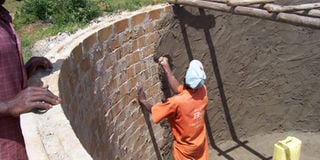A low-cost water tank

Workers building an underground water tank using interlocking bricks. photo by Michael J. Ssali
What you need to know:
This water storage facility uses less mortar, lasts longer than other options and costs much less.
For those in areas where water is scarce it makes sense to have where to store water. For a household to store enough rainwater to meet domestic needs and for the farm, a large water tank is required.
Some go for metallic water tanks, the largest of which cost about Shs1m each. But the metal rusts after about seven or 10 years when a replacement is needed. Large plastic tanks are expensive—at about Shs4m for a 10,000-litre tank.
Long lasting
However, for nearly half that amount , it is possible to construct an equally large rainwater tank that may last for up to 30 years, using Interlocking Stabilised Soil Bricks (ISSB).
This technology of using ISSBs was developed in 1993 by a Makerere University lecturer, Dr Moses Musaazi.
It is used by Brick by Brick Construction, a Rakai-based NGO, to build low-cost and long lasting rainwater tanks, whose capacity ranges from 10,000 to 30,000 litres, for both institutions such as schools and health facilities, and private households.
Environment friendly
However, it should be noted that the ISSB technology is not also used for water tanks but also in other construction projects like building classrooms and latrines.
Mr Max Ssenyonga, the programme coordinator and manager of Brick by Brick Construction describes the technology as environment friendly because the bricks used to construct are not burned.
The bricks are made from the underground soil, which means that the humus-rich top soil is spared.
The common practice for most people making bricks is to dig up tonnes upon tonnes of clay from wetlands, where entire ecosystems get destroyed, leading to reduced biodiversity and potential loss of plant and animal populations.
Positive aspects
Swamps and wetlands are the natural ways of water treatment and filtration and when they are destroyed due to activities such as brick-making, the loss is catastrophic for the natural environment and human survival.
“Nearly everywhere one sees piles of clay bricks burned with wood, which shows that all the time more and more trees are cut down to burn bricks,” Ssenyonga says.
“Due to an increasing population, more buildings will have to be built. The destruction of the environment to get clay and wood to burn the bricks will go on until people begin to appreciate the environmentally positive aspects of ISSB technology.”
The ISSB technology mostly uses murraum subsoil with just a little cement and lime to make bricks. The materials are mixed and put into a specially designed brick press machine.
Since the bricks interlock in both the vertical and horizontal directions, less mortar is needed between them during the building, Therefore, it is a lot cheaper to use ISSBs for construction.




